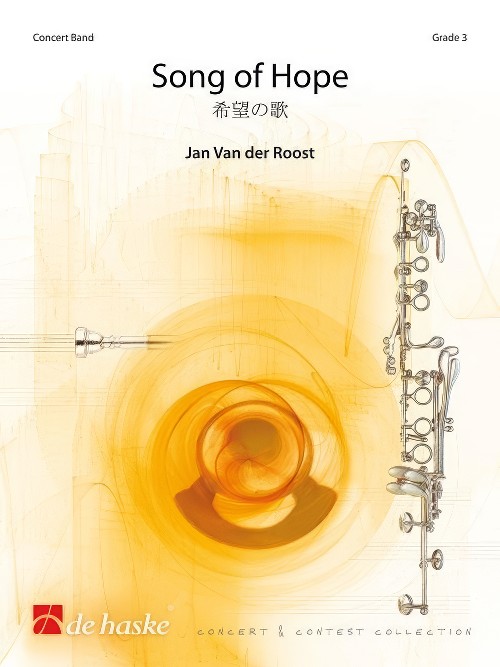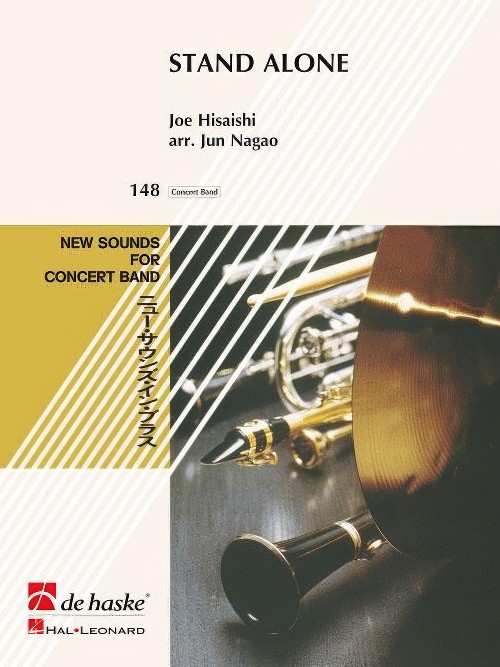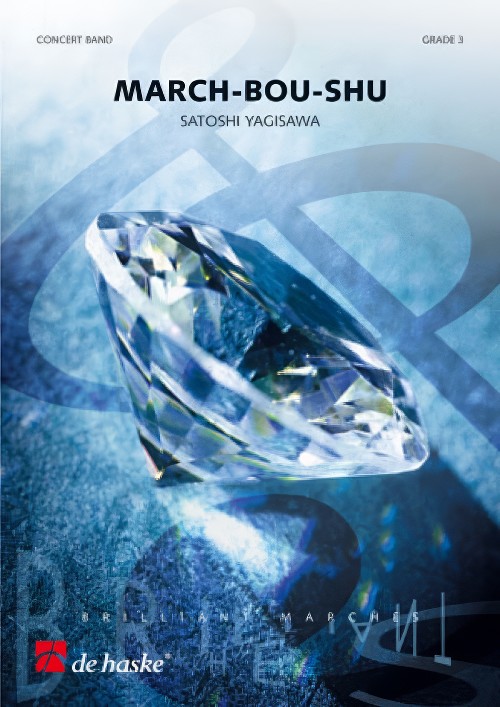Results
-
 £104.99
£104.99Song of Hope (Concert Band - Score and Parts) - Van der Roost, Jan
2011 was a disastrous year for Japan: on March 11 the northeast of the country suffered a violent earthquake, which triggered a huge tsunami and caused massive damage to people and the environment. The ensuing problems with the nuclear reactor at Fukushima only increased the misery: a black day in the country's history... One almost inevitable consequence of such dramatic circumstances is the particular damage suffered by the cultural arts. And so it was in Japan: various high school wind orchestras in the effected areas lost their practice rooms and/or instruments. It will take a long time before the damage suffered is repaired - and it will take great effort to overcome the psychological effects, too. Focusing on the latter, Yutada Nishida (director of The Bandwagon radio program) asked a few composers for a simple work that could be played by many orchestras. It just so happened that the Osakan Philharmonic Winds (with whom Jan Van der Roost had conducted a concert exclusively of his own works on September 25th) had had a similar idea. This concert saw the baptism of Song of Hope. This piece immediately struck a chord with musicians and audience alike: it begins bleakly in the low register and evolves to a more open, optimistic close. There really is hope for better times!Duration: 4:45
Estimated dispatch 7-14 working days
-
 £104.99
£104.99Song of Hope - Jan Van der Roost
2011 was a disastrous year for Japan: on March 11 the northeast of the country suffered a violent earthquake, which triggered a huge tsunami and caused massive damage to people and the environment. The ensuing problems with the nuclear reactor atFukushima only increased the misery: a black day in the country's history...One almost inevitable consequence of such dramatic circumstances is the particular damage suffered by the cultural arts. And so it was in Japan: various high school wind orchestras in the effected areas lost their practice rooms and/or instruments.It will take a long time before the damage suffered is repaired - and it will take great effort to overcome the psychological effects, too. Focusing on the latter, Yutada Nishida (director of The Bandwagon radio program) asked a few composers fora simple work that could be played by many orchestras. It just so happened that the Osakan Philharmonic Winds (with whom Jan Van der Roost had conducted a concert exclusively of his own works on September 25th) had had a similar idea. This concert saw the baptism of Song of Hope. This pieceimmediately struck a chord with musicians and audience alike: it begins bleakly in the low register and evolves to a more open, optimistic close. There really is hope for better times!
Estimated dispatch 7-14 working days
-
 £267.50
£267.50Gloriosa - Symphonic Poem for Band (Complete) - Yasuhide Ito
A new acquisition by Bravo Music, this fresh printing of the 1990 masterwork by Yasuhide Ito features a newly engraved score, improved parts, good availability and value. This stirring and powerful homage to early Christianity in Japan profoundly andeloquently states the case of cross-cultural conflict and resolution.Commissioned in 1989 and premiered in 1990 by the Sasebo Band of the Maritime Self-Defense Force of Kyushu, southern Japan.Gloriosa is inspired by the songs of the Kakure-Kirishitan (Crypto-Christians) of Kyushu who continued to practice their faith surreptitiously after the ban of Christianity, which had been introduced to that southern region in the mid-16th century byRoman Catholic missionary Francisco Xavier. The worship brought with it a variety of western music.Though Christianity was proscribed in 1612 by authority of the Tokugawa Shogunate in Edo (today Tokyo), Kakure-Kirishitan continued advocating sermons and disguised songs. Melodies and lyrics such as Gregorian chant were obliged to be "Japanized".For example, the Latin word "Gloriosa" was changed to "Gururiyoza." This adaptation of liturgy for survival inspired Ito to write this piece in order to reveal and solve this unique cultural mystery.The composer explains:"Nagasaki district in Kyushu region continued to accept foreign culture even during the seclusion period, as Japan's only window to the outer world. After the proscription of Christianity, the faith was preserved and handed down in secret in theNagasaki and Shimabara areas of Kyushu region. My interest was piqued by the way in which the Latin words of Gregorian chants were gradually 'Japanized' during the 200 years of hidden practice of the Christian faith. That music forms the basis ofGloriosa."I. OratioThe Gregorian chant "Gloriosa" begins with the words, "O gloriosa Domina excelsa super sidera que te creavit provide lactasti sacro ubere." The first movement Oratio opens with bells sounding the hymn's initial phrases. The movement as a whole evokesthe fervent prayers and suffering of the Crypto-Christians.II. CantusThe second movement, Cantus showcases a brilliant blend of Gregorian chant and Japanese elements by opening with a solo passage for the ryuteki, a type of flute. The theme is based on San Juan-sama no Uta (The Song of Saint John), a 17th-century songcommemorating the "Great Martyrdom of Nagasaki" where a number of Kyushu Christians were killed in 1622.II. Dies FestusThe third and final movement, Dies Festus, takes as its theme the Nagasaki folk song, Nagasaki Bura Bura Bushi, where many Crypto-Christians lived.Gloriosa, fusing Gregorian chant and Japanese folk music, displays the most sophisticated counterpoint yet found in any Japanese composition for wind orchestra.
Estimated dispatch 7-14 working days
-
£144.99
Gloriosa - Symphonic Poem for Band Mvt 2 & 3 - Yasuhide Ito
A new acquisition by Bravo Music, this fresh printing of the 1990 masterwork by Yasuhide Ito features a newly engraved score, improved parts, good availability and value. This stirring and powerful homage to early Christianity in Japan profoundly andeloquently states the case of cross-cultural conflict and resolution.I. OratioII. CantusThe second movement, Cantus showcases a brilliant blend of Gregorian chant and Japanese elements by opening with a solo passage for the ryuteki, a type of flute. The theme is based on San Juan-sama no Uta (The Song of Saint John), a 17th-century songcommemorating the "Great Martyrdom of Nagasaki" where a number of Kyushu Christians were killed in 1622.III. Dies FestusThe third and final movement, Dies Festus, takes as its theme the Nagasaki folk song, Nagasaki Bura Bura Bushi, where many Crypto-Christians lived.Commissioned in 1989 and premiered in 1990 by the Sasebo Band of the Maritime Self-Defense Force of Kyushu, southern Japan.Gloriosa is inspired by the songs of the Kakure-Kirishitan (Crypto-Christians) of Kyushu who continued to practice their faith surreptitiously after the ban of Christianity, which had been introduced to that southern region in the mid-16th century byRoman Catholic missionary Francisco Xavier. The worship brought with it a variety of western music.
Estimated dispatch 7-14 working days
-
 £104.99
£104.99Stand Alone (Concert Band - Score and Parts) - Hisaishi, Joe - Nagao, Jun
Joe Hisaishi is a highly sought-after film score composer in his home country of Japan. Among his numerous movie scores are several for anime fi lms. Anyone who watched the 1998 Nagano Winter Olympics heard his work, whether they knew it or not, as he composed the music for the opening ceremony. Stand Alone is an emotional song written for a Japanese TV-series, recorded by none other than Sarah Brightman. (She even sung in Japanese!) Joe Hisaishi's music can now be enjoyed by an even wider audience thanks to this arrangement by fellow countryman Jun Nagao.Duration: 4:45
Estimated dispatch 7-14 working days
-
 £104.99
£104.99Stand Alone - Joe Hisaishi
Joe Hisaishi is a highly sought-after film score composer in his home country of Japan. Among his numerous movie scores are several for anime fi lms. Anyone who watched the 1998 Nagano Winter Olympics heard his work, whether they knew it or not, as he composed the music for the opening ceremony. Stand Alone is an emotional song written for a Japanese TV-series, recorded by none other than Sarah Brightman. (She even sung in Japanese!) Joe Hisaishi's music can now be enjoyed by an even wider audience thanks to this arrangement by fellow countryman Jun Nagao.
Estimated dispatch 7-14 working days
-
 £94.99
£94.99March-Bou-Shu (Concert Band - Score and Parts) - Yagisawa, Satoshi
This work was commissioned by the All Japan Band Association (Chiba Prefecture) to commemorate their 45th anniversary. The composer, Satoshi Yagisawa, was requested to write a march that was easy enough for junior high school students to play, and was based on the folk songs in Chiba Prefecture. After several months of research the composer finally discovered Boushu Oiwake, a lyrical folk song sung with the Japanese bamboo flute and shamisen (three-stringed Japanese instrument). After the composition process has been completed we have here a fantastic triumphant march sure to 'raise the roof' at any performance.Duration: 3:45
Estimated dispatch 7-14 working days
-
 £94.99
£94.99March-Bou-Shu - Satoshi Yagisawa
This work was commissioned by the All Japan Band Association (Chiba Prefecture) to commemorate their 45th anniversary. The composer, Satoshi Yagisawa, was requested to write a march that was easy enough for junior high school students to play, and was based on the folk songs in Chiba Prefecture. After several months of research the composer finally discovered Boushu Oiwake, a lyrical folk song sung with the Japanese bamboo flute and shamisen (three-stringed Japanese instrument). After the composition process has been completed we have here a fantastic triumphant march sure to ?raise the roof? at any performance.
Estimated dispatch 7-14 working days
